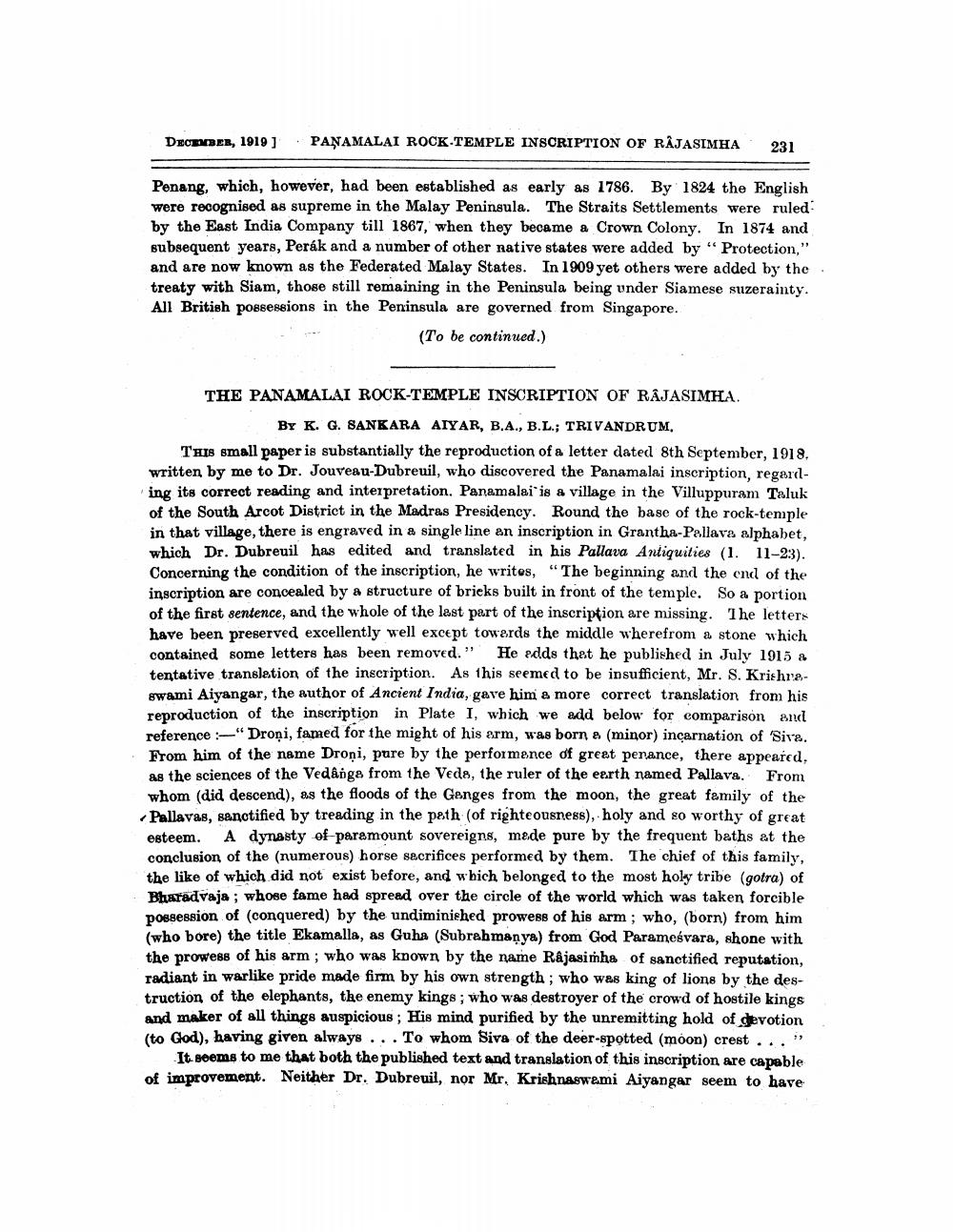________________
PANAMALAI ROCK-TEMPLE INSCRIPTION OF RAJASIMHA 231
Penang, which, however, had been established as early as 1786. By 1824 the English were recognised as supreme in the Malay Peninsula. The Straits Settlements were ruled by the East India Company till 1867, when they became a Crown Colony. In 1874 and subsequent years, Perák and a number of other native states were added by "Protection," and are now known as the Federated Malay States. In 1909 yet others were added by the treaty with Siam, those still remaining in the Peninsula being under Siamese suzerainty. All British possessions in the Peninsula are governed from Singapore..
(To be continued.)
DECEMBER, 1919]
THE PANAMALAI ROCK-TEMPLE INSCRIPTION OF RAJASIMHA
BY K. G. SANKARA AIYAR, B.A., B.L.; TRIVANDRUM,
THIS small paper is substantially the reproduction of a letter dated 8th September, 1918. written by me to Dr. Jouveau-Dubreuil, who discovered the Panamalai inscription, regarding its correct reading and interpretation. Panamalai is a village in the Villuppuram Taluk of the South Arcot District in the Madras Presidency. Round the base of the rock-temple in that village, there is engraved in a single line an inscription in Grantha-Pallava alphabet, which Dr. Dubreuil has edited and translated in his Pallava Antiquities (1. 11-23). Concerning the condition of the inscription, he writes, "The beginning and the end of the inscription are concealed by a structure of bricks built in front of the temple. So a portion of the first sentence, and the whole of the last part of the inscription are missing. The letters have been preserved excellently well except towards the middle wherefrom a stone which contained some letters has been removed. " He adds that he published in July 1915 a tentative translation of the inscription. As this seemed to be insufficient, Mr. S. Krishnaswami Aiyangar, the author of Ancient India, gave him a more correct translation from his reproduction of the inscription in Plate I, which we add below for comparison and reference :-"Droņi, famed for the might of his arm, was born a (minor) incarnation of 'Siva. From him of the name Droņi, pure by the performance of great penance, there appeared, as the sciences of the Vedânge from the Veda, the ruler of the earth named Pallava. From whom (did descend), as the floods of the Ganges from the moon, the great family of the Pallavas, sanctified by treading in the path (of righteousness), holy and so worthy of great esteem. A dynasty of paramount sovereigns, made pure by the frequent baths at the conclusion of the (numerous) horse sacrifices performed by them. The chief of this family, the like of which did not exist before, and which belonged to the most holy tribe (gotra) of Bharadvaja; whose fame had spread over the circle of the world which was taken forcible possession of (conquered) by the undiminished prowess of his arm; who, (born) from him (who bore) the title Ekamalla, as Guha (Subrahmanya) from God Parameśvara, shone with the prowess of his arm; who was known by the name Rajasimha of sanctified reputation, radiant in warlike pride made firm by his own strength; who was king of lions by the destruction of the elephants, the enemy kings; who was destroyer of the crowd of hostile kings and maker of all things auspicious; His mind purified by the unremitting hold of devotion (to God), having given always... To whom Siva of the deer-spotted (moon) crest . . . " It seems to me that both the published text and translation of this inscription are capable of improvement. Neither Dr. Dubreuil, nor Mr. Krishnaswami Aiyangar seem to have




